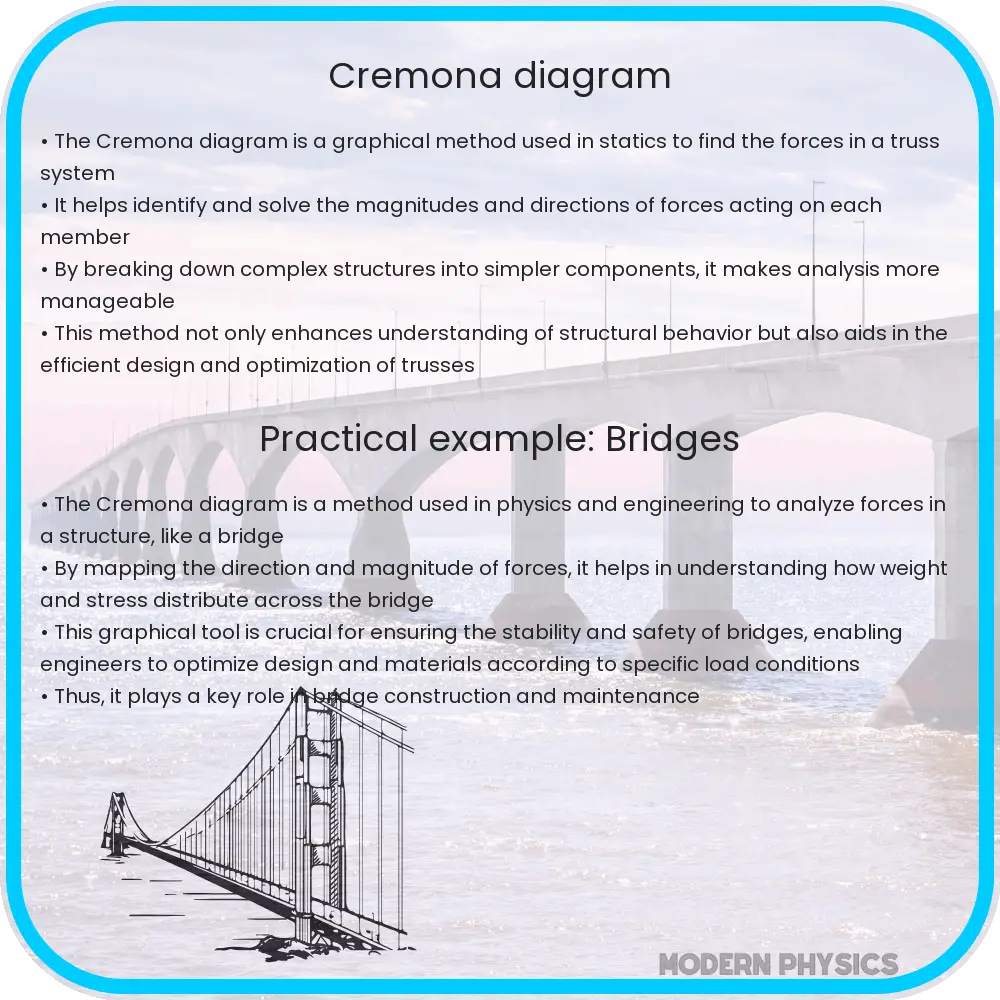A Cremona diagram is a graphical tool used in engineering statics to analyze and visualize the forces within truss structures, simplifying complex calculations.

Understanding the Cremona Diagram
In the field of engineering, particularly within the discipline of statics, the Cremona diagram serves as a powerful tool for visually analyzing the forces within a structure. This method, named after the Italian mathematician Luigi Cremona, is a graphical technique that helps engineers and students alike understand how forces are distributed within truss systems.
The Basics of a Cremona Diagram
The core principle of the Cremona diagram revolves around creating a scaled map of forces, which are represented as vectors. The diagram is particularly useful for structures where numerous concurrent forces act, such as bridges or roof trusses. It simplifies complex force calculations by providing a visual summary of how forces balance out within the system.
Steps to Draw a Cremona Diagram
- Determine the External Forces: Begin by calculating the external forces acting on the truss, including applied loads and reactions at supports. These forces are usually found through equilibrium equations of the overall structure.
- Analyze Each Joint: The next step is to look at each joint within the truss and apply the method of joints. This means drawing free-body diagrams for each joint and solving for the forces in the connecting members.
- Begin Drawing: Starting from a joint where at least one known force (usually a reaction) and no more than two unknown forces are present, begin plotting your vectors corresponding to each force. Each force vector is drawn from the tail of the previous vector such that all vectors form a closed polygon.
- Maintain Direction and Magnitude: It is crucial to maintain the correct direction of each force (tension or compression) and proportionally scale the magnitude of forces in your diagram.
- Complete the Force Polygon: Continue the process for each joint. When done correctly, the last vector should end at the starting point of the first vector, closing the polygon. This closure confirms the balance of forces and moments within the structure.
Applications of Cremona Diagrams
Cremona diagrams are not only fundamental in educational settings to teach students about force balance and vector representation, but they are also practically applied in the analysis and design of trusses in engineering projects. By providing a clear and simple way to verify the conditions of equilibrium, these diagrams help engineers ensure that structures will withstand the forces they are subjected to.
Advantages of Using Cremona Diagrams
- Visual Clarity: Allows for a clear visual representation of force interactions, making it easier to spot errors and understand the flow of forces.
- Simplicity: Simplifies the process of checking complex structures where multiple forces are involved.
- Educational Utility: Acts as an excellent educational tool for teaching the principles of force balance and static equilibrium.
The Cremona diagram, with its methodical approach to visualizing and solving for forces, is an essential tool in the arsenal of an engineer or student dealing with static analysis. With these diagrams, the abstract concepts of force balance and equilibrium become tangible and intuitive.
Challenges and Limitations of Cremona Diagrams
While Cremona diagrams are valuable in understanding and analyzing structural forces, they come with certain challenges. The accuracy of a Cremona diagram heavily depends on the precision of the initial force calculations and the meticulousness in maintaining scale and direction in drawing. Misinterpretation and drawing errors can lead to incorrect conclusions, which in critical engineering projects could compound into significant issues. Additionally, for very complex trusses, the diagram can become overly crowded and difficult to interpret, limiting its practical utility in these contexts.
Modern Enhancements to Cremona Diagrams
With advancements in technology, traditional Cremona diagrams have been enhanced through digital tools. Software applications can now generate these diagrams quickly and with greater accuracy, reducing the manual effort required and minimizing human errors. These tools also allow for easy adjustments and iterations, providing engineers with the flexibility to explore different scenarios and optimize truss designs efficiently.
Conclusion
The Cremona diagram remains an indispensable tool in the field of engineering statics, revered for its ability to simplify complex interactions of forces within a truss system. Despite some challenges, its benefits in terms of visual clarity, educational value, and simplicity make it a staple in both academic and real-world applications. As we move forward, the integration of digital tools continues to refine and expand the capabilities of these diagrams, ensuring that they remain relevant and useful in the ever-evolving field of engineering. By leveraging both traditional and modern approaches, engineers can continue to rely on Cremona diagrams to bring clarity and precision to the structural analysis process.
